Structural Change and Dynamics of Pakistan Stock Market during Crisis: A Complex Network Perspective
Abstract
:1. Introduction
2. Literature Review
3. Data and Methodology
4. Results and Discussion
4.1. Correlation Coefficients and Distance Matrices
4.2. Shannon Entropy
4.3. Threshold Network
4.4. Minimum Spanning Tree
4.5. Scale-Free Strcuture of MSTs
4.6. Dynamic Structures of MSTs
4.6.1. Degree Distribution
4.6.2. Normalized Tree Length
5. Conclusions
Author Contributions
Funding
Conflicts of Interest
Appendix A
| Node | Ticker | Company Name | Sector | Color |
|---|---|---|---|---|
| 1 | ABL | Allied Bank Limited | Commercial Banks | RED |
| 2 | ABOT | Abbot Laboatories (Pakistan) Limited | Pharmaceuticals | GREEN |
| 3 | ACPL | Attock Cement (Pakistan) Limited | Cement | BLUE |
| 4 | ADOS | Ados Pakistan Limited | Engineering | HAZEL GREEN |
| 5 | AGTL | Al-Ghazi Tractors Limited | Automobile Assembler | PURPLE |
| 6 | AHCL | Arif Habib Corporation Limited | Fertilizer | OLIVE |
| 7 | AICL | Adamjee Insurance Company Limited | Insurance | CYAN |
| 8 | AKBL | Askari Bank Limited | Commercial Banks | RED |
| 9 | ANL | Azgard Nine Limited | Textile Composite | KHAKI |
| 10 | APL | Attock Petroleum Limited | Oil and Gas Marketing Companies | ORANGE |
| 11 | ATBA | Atlas Battery Limited | Automobile Parts & Accessories | PURPLE |
| 12 | ATLH | Atlas Honda Limited | Automobile Assembler | PURPLE |
| 13 | ATRL | Attock Refinery Limited | Refinery | INDIGO |
| 14 | BAFL | Bank Al-Falah Limited | Commercial Banks | RED |
| 15 | BAHL | Bank Al-Habib Limited | Commercial Banks | RED |
| 16 | BATA | Bata Pakistan Limited | Leather and Tanneries | CELESTE |
| 17 | BERG | Berger Paints Pakistan Limited | Chemical | YELLOW |
| 18 | BIPL | Bankislami Pakistan Limited | Commercial Banks | RED |
| 19 | BNWM | Bannu Woollen Mills Limited | Woollen | SALMON |
| 20 | BOK | Bank of Khyber Limited | Commercial Banks | RED |
| 21 | BOP | Bank of Punjab Limited | Commercial Banks | RED |
| 22 | BPL | Burshane LPG (Pakistan) Limited | Oil and Gas Marketing Companies | ORANGE |
| 23 | BRR | B.R.R. Guardian Modaraba | Modarabas | GREY |
| 24 | BWCL | Bestway Cement Limited | Cement | BLUE |
| 25 | BYCO | Byco Petroleum Pakistan Limited | Refinery | INDIGO |
| 26 | CENI | Century Insurance Company Limited | Insurance | CYAN |
| 27 | CEPB | Century Paper and Board Mills Limited | Paper and Board | SILVER |
| 28 | CFL | Crescent Fibres Limited | Textile Spinning | KHAKI |
| 29 | CHBL | Chenab Limited | Textile Composite | KHAKI |
| 30 | CHCC | Cherat Cement Company Limited | Cement | BLUE |
| 31 | CJPL | Crescent Jute Proudcts Limited | Jute | BLACK |
| 32 | CLOV | Clover Pakistan Limited | Food and Personal Care Products | CHARCOAL |
| 33 | COLG | Colgate Palmolive (Pakistan) Limited | Chemical | YELLOW |
| 34 | CPPL | Cherat Packaging Limited. | Paper and Board | SILVER |
| 35 | CSAP | Crescent Steel & Allied Products Limited | Engineering | HAZEL GREEN |
| 36 | CSM | Crescent Standard Modaraba | Modarabas | GREY |
| 37 | DAWH | Dawood Hercules Corporation Limited | Fertilizer | OLIVE |
| 38 | DCL | Dewan Cement Limited | Cement | BLUE |
| 39 | DFML | Dewan Farooque Motors Limited | Automobile Assembler | PURPLE |
| 40 | DGKC | D.G. Khan Cement Company Limited | Cement | BLUE |
| 41 | DLL | Dawood Lawrancepur Limited | Textile Composite | KHAKI |
| 42 | DNCC | Dandot Cement Company Limited | Cement | BLUE |
| 43 | DSFL | Dewan Salman Fibre Limited | Synthetic and Rayon | PLATINUM |
| 44 | DSIL | D.S. Industires Limited | Textile Spinning | KHAKI |
| 45 | DWSM | Dewan Sugar Mills Limited | Sugar and Allied Industries | MAGENTA |
| 46 | DYNO | Dynea Pakistan Limited | Chemical | YELLOW |
| 47 | ECOP | Ecopack Limited | Miscellaneous | BROWN |
| 48 | EFUG | EFU General Insurance Limited | Insurance | CYAN |
| 49 | EFUL | EFU Life Assurance Limited | Insurance | CYAN |
| 50 | EMCO | Emco Industries Limited | Glass and Ceramics | GUNMETAL |
| 51 | ENGRO | Engro Corporation Limited | Fertilizer | OLIVE |
| 52 | EXIDE | Exide Pakistan Limited | Automobile Parts and Accessories | PURPLE |
| 53 | FABL | Faysal Bank Limited | Commercial Banks | RED |
| 54 | FCCL | Fauji Cement Company Limited | Cement | BLUE |
| 55 | FCSC | First Capital Securites Corporation Limited | Inv. Banks/Inv. Cos./Securities Cos. | LIME |
| 56 | FDIBL | First Dawood Investment Bank Limited | Inv. Banks/Inv. Cos./Securities Cos. | LIME |
| 57 | FECM | First Elite Capital Modaraba | Modarabas | GREY |
| 58 | FECTC | Fecto Cement Limited | Cement | BLUE |
| 59 | FEM | First Equity Modarba | Modarabas | GREY |
| 60 | FEROZ | Ferozsons Laboratories Limited | Pharmaceuticals | GREEN |
| 61 | FFBL | Fauji Fertilizer Bin Qasim Limited | Fertilizer | OLIVE |
| 62 | FFC | Fauji Fertilizer Company Limited | Fertilizer | OLIVE |
| 63 | FHAM | First Habib Modarba Limited | Modarabas | GREY |
| 64 | FNBM | First National Bank Modarba | Modarabas | GREY |
| 65 | FNEL | First National Equities Limited | Inv. Banks/Inv. Cos./Securities Cos. | LIME |
| 66 | GADT | Gadoon Textile Mills Limited | Textile Spinning | KHAKI |
| 67 | GASF | Golden Arrow Selected Funds Limited | Close-End Mutual Fund | ROSEGOLD |
| 68 | GATI | Gatron Industries Limited | Synthetic and Rayon | PLATINUM |
| 69 | GATM | Gul Ahmed Textile Mills Limited | Textile Composite | KHAKI |
| 70 | GHGL | Ghani Glass Limited | Glass and Ceramics | GUNMETAL |
| 71 | GHNL | Ghandara Nissan Limited | Automobile Assembler | PURPLE |
| 72 | GLAXO | GlaxoSmithKline (Pakistan) Limited | Pharmaceuticals | GREEN |
| 73 | GTYR | General Tyre and Rubber Co. of Pakistan Limited | Automobile Parts and Accessories | PURPLE |
| 74 | GWLC | Gharibwal Cement Limited | Cement | BLUE |
| 75 | HABSM | Habib Sugar Mills Limited | Sugar and Allied Industries | MAGENTA |
| 76 | HAL | Habib-ADM Limited | Sugar and Allied Industries | MAGENTA |
| 77 | HCAR | Honda Atlas Cars (Pakistan) Limited | Automobile Assembler | PURPLE |
| 78 | HICL | Habib Insurance Company Limited | Insurance | CYAN |
| 79 | HIFA | HBL Investment Fund | Close-End Mutual Fund | ROSEGOLD |
| 80 | HINO | HinoPak Motors Limited | Automobile Assembler | PURPLE |
| 81 | HINOON | Highnoon Laboratories Limited | Pharmaceuticals | GREEN |
| 82 | HMB | Habib Metropolitan Bank Limited | Commercial Banks | RED |
| 83 | HSPI | Huffaz Seamless Pipe Industries Limited | Engineering | HAZEL GREEN |
| 84 | HUBC | Hub Power Company Limited | Power Generation and Distribution | LIGHTBLUE |
| 85 | HUMNL | Hum Network Limited | Technology and Communication | TEAL |
| 86 | ICI | I.C.I. Pakistan Limited | Chemical | YELLOW |
| 87 | ICIBL | Invest Capital Investment Bank Limited | Inv. Banks/Inv. Cos./Securities Cos. | LIME |
| 88 | IGIHL | IGI Holdings Limited | Insurance | CYAN |
| 89 | INDU | Indus Motor Company Limited | Automobile Assembler | PURPLE |
| 90 | INIL | International Industries Limited | Engineering | HAZEL GREEN |
| 91 | JGICL | Jubilee General Insurance Company Limited | Insurance | CYAN |
| 92 | JLICL | Jubilee Life Insurance Company Limited | Insurance | CYAN |
| 93 | JOPP | Johnson and Phillips (Pakistan) Limited | Cable and Electric Goods | CREAM |
| 94 | JPGL | Japan Power Generation Limited | Power Generation and Distribution | LIGHTBLUE |
| 95 | JSCL | Jahangir Siddiqui Company Limited | Inv. Banks/Inv. Cos./Securities Cos. | LIME |
| 96 | JSGCL | JS Global Capital Limited | Inv. Banks/Inv. Cos./Securities Cos. | LIME |
| 97 | KAPCO | Kot Addu Power Company Limited | Power Generation and Distribution | LIGHTBLUE |
| 98 | KEL | K-Electric Limited | Power Generation and Distribution | LIGHTBLUE |
| 99 | KOHC | Kohat Cement Limited | Cement | BLUE |
| 100 | KOHE | Kohinoor Energy Limited | Power Generation and Distribution | LIGHTBLUE |
| 101 | KTML | Kohinoor Textile Mills Limited | Textile Composite | KHAKI |
| 102 | LUCK | Lucky Cement Limited | Cement | BLUE |
| 103 | MACFL | Macpac Films Limited | Miscellaneous | BROWN |
| 104 | MARI | Mari Petroleum Company Limited | Oil and Gas Exploration Companies | ORANGE |
| 105 | MCB | MCB Bank Limited | Commercial Banks | RED |
| 106 | MEBL | Meezan Bank Limited | Commercial Banks | RED |
| 107 | MERIT | Merit Packaging Limited | Paper and Board | SILVER |
| 108 | MFFL | Mitchells Fruit Farms Limited | Food and Personal Care Products | CHARCOAL |
| 109 | MLCF | Maple Leaf Cement Factory Limited | Cement | BLUE |
| 110 | MRNS | Mehran Sugar Mills Limited | Sugar and Allied Industries | MAGENTA |
| 111 | MTL | Millat Tractors Limited | Automobile Assembler | PURPLE |
| 112 | MUREB | Murree Brewery Company Limited | Food and Personal Care Products | CHARCOAL |
| 113 | MZSM | Mirza Sugar Mills Limited | Sugar and Allied Industries | MAGENTA |
| 114 | NATF | National Foods Limited | Food and Personal Care Products | CHARCOAL |
| 115 | NBP | National Bank of Pakistan | Commercial Banks | RED |
| 116 | NCL | Nishat Chunian Limited | Textile Composite | KHAKI |
| 117 | NESTLE | Nestle Pakistan Limited | Food and Personal Care Products | CHARCOAL |
| 118 | NETSOL | NetSol Technologies Limited | Technology and Communication | TEAL |
| 119 | NICL | Nimir Industrial Chemicals Limited | Chemical | YELLOW |
| 120 | NML | Nishat Mills Limited | Textile Composite | KHAKI |
| 121 | NRL | National Refinery Limited | Refinery | INDIGO |
| 122 | OGDC | Oil and Gas Development Company Limited | Oil and Gas Exploration Companies | ORANGE |
| 123 | OLPL | Orix Leasing Pakistan Limited | Leasing | NAVY |
| 124 | OTSU | Otsuka Pakistan Limited | Pharmaceuticals | GREEN |
| 125 | PAEL | Pak Elektron Limited | Cable and Electric Goods | CREAM |
| 126 | PAKD | Pak Datacom Limited | Technology and Communication | TEAL |
| 127 | PAKOXY | Pakistan Oxygen Limited | Chemical | YELLOW |
| 128 | PAKRI | Pakistan Reinsurance Company Limited | Insurance | CYAN |
| 129 | PAKT | Pakistan Tobacco Company Limited | Tobacco | CORAL |
| 130 | PCAL | Pakistan Cables Limited | Cable and Electric Goods | CREAM |
| 131 | PIAA | Pakistan International Airlines Corporation | Transport | MAROON |
| 132 | PICT | Pakistan International Container Terminal Limited | Transport | MAROON |
| 133 | PINL | Premier Insurance Limited | Insurance | CYAN |
| 134 | PIOC | Pioneer Cement Limited | Cement | BLUE |
| 135 | PKGS | Packages Limited | Paper and Board | SILVER |
| 136 | PMI | First Prudential Modarba | Modarabas | GREY |
| 137 | PMPK | Philip Morris (Pakistan) Limited | Tobacco | CORAL |
| 138 | PNSC | Pakistan National Shipping Corporation Limited | Transport | MAROON |
| 139 | POL | Pakistan Oilfields Limited | Oil and Gas Exploration Companies | ORANGE |
| 140 | PPL | Pakistan Petroleum Limited | Oil and Gas Exploration Companies | ORANGE |
| 141 | PRL | Pakistan Refinery Limited | Refinery | INDIGO |
| 142 | PSEL | Pakistan Services Limited | Miscellaneous | BROWN |
| 143 | PSMC | Pak Suzuki Motor Company Limited | Automobile Assembler | PURPLE |
| 144 | PSO | Pakistan State Oil Company Limited | Oil and Gas Marketing Companies | ORANGE |
| 145 | PTC | Pakistan Telecommunication Company Limited | Technology and Communication | TEAL |
| 146 | QUICE | Quice Food Limited | Food and Personal Care Products | CHARCOAL |
| 147 | SAPL | Sanofi-Aventis Pakistan Limited | Pharmaceuticals | GREEN |
| 148 | SBL | Samba Bank Limited | Commercial Banks | RED |
| 149 | SEARL | The Searle Company Limited | Pharmaceuticals | GREEN |
| 150 | SEPL | Security Paper Limited | Paper and Board | SILVER |
| 151 | SHEL | Shell Pakistan Limited | Oil and Gas Marketing Companies | ORANGE |
| 152 | SHEZ | Shezan International Limited | Food and Personal Care Products | CHARCOAL |
| 153 | SHFA | Shifa International Hospitals Limited | Miscellaneous | BROWN |
| 154 | SHSML | Shahmurad Sugar Mills Limited | Sugar and Allied Industries | MAGENTA |
| 155 | SIEM | Siemens Pakistan Engineering Co. Limited | Cable and Electric Goods | CREAM |
| 156 | SILK | Silkbank Limited | Commercial Banks | RED |
| 157 | SITC | Sitara Chemical Industries Limited | Chemical | YELLOW |
| 158 | SMTM | Samin Textiles Limited | Textile Weaving | KHAKI |
| 159 | SNAI | Sana Industries Limited | Textile Spinning | KHAKI |
| 160 | SNBL | Soneri Bank Limited | Commercial Banks | RED |
| 161 | SNGP | Sui Northern Gas Pipelines Limited | Oil and Gas Marketing Companies | ORANGE |
| 162 | SPLC | Saudi Pak Leasing Company Limited | Leasing | NAVY |
| 163 | SRVI | Service Industries Limited | Leather and Tanneries | CELESTE |
| 164 | SSGC | Sui Southern Gas Company Limited | Oil and Gas Marketing Companies | ORANGE |
| 165 | STCL | Shabbir Tiles and Ceramics Limited | Glass and Ceramics | GUNMETAL |
| 166 | STPL | Siddiqsons Tin Plate Limited | Miscellaneous | BROWN |
| 167 | TELE | Telecard Limited | Technology and Communication | TEAL |
| 168 | TGL | Tariq Glass Industries Limited | Glass and Ceramics | GUNMETAL |
| 169 | THALL | Thal Limited | Automobile Parts and Accessories | PURPLE |
| 170 | TREET | Treet Corporation Limited | Food and Personal Care Products | CHARCOAL |
| 171 | TRG | TRG Pakistan Limited | Technology and Communication | TEAL |
| 172 | TRIBL | Trust Investment Bank Limited | Inv. Banks/Inv. Cos./Securities Cos. | LIME |
| 173 | TRIPF | Tri-Pack Films Limited | Miscellaneous | BROWN |
| 174 | TSPL | Tri-Star Power Limited | Power Generation and Distribution | LIGHTBLUE |
| 175 | UBL | United Bank Limited | Commercial Banks | RED |
| 176 | UDPL | United Distributors Pakistan Limited | Miscellaneous | BROWN |
| 177 | WAHN | Wah Noble Chemicals Limited | Chemical | YELLOW |
| 178 | WAVES | Waves Singer Pakistan Limited | Cable and Electric Goods | CREAM |
| 179 | WTL | WorldCall Telecom Limited | Technology and Communication | TEAL |
| 180 | ZIL | ZIL Limited | Food and Personal Care Products | CHARCOAL |
| 181 | ZTL | Zephyr Textile Limited | Textile Weaving | KHAKI |
References
- Chen, Y.; Mantegna, R.N.; Pantelous, A.A.; Zuev, K.M. A dynamic analysis of S&P 500, FTSE 100 and EURO STOXX 50 indices under different exchange rates. PLoS ONE 2018, 13, e0194067. [Google Scholar] [PubMed]
- Mantegna, R.N. Hierarchical structure in financial markets. Eur. Phys. J. B 1999, 11, 193–197. [Google Scholar] [CrossRef]
- Dias, J. Spanning trees and the Eurozone crisis. Phys. A Stat. Mech. Its Appl. 2013, 392, 5974–5984. [Google Scholar] [CrossRef]
- Matesanz, D.; Ortega, G.J. Sovereign public debt crisis in Europe. A network analysis. Phys. A Stat. Mech. Its Appl. 2015, 436, 756–766. [Google Scholar] [CrossRef]
- Majapa, M.; Gossel, S.J. Topology of the South African stock market network across the 2008 financial crisis. Phys. A Stat. Mech. Its Appl. 2016, 445, 35–47. [Google Scholar] [CrossRef]
- Zhao, L.; Li, W.; Cai, X. Structure and dynamics of stock market in times of crisis. Phys. Lett. A 2016, 380, 654–666. [Google Scholar] [CrossRef]
- Onnela, J.P.; Chakraborti, A.; Kaski, K.; Kertész, J. Dynamic asset trees and Black Monday. Phys. A Stat. Mech. Its Appl. 2003, 324, 247–252. [Google Scholar] [CrossRef]
- Li, B.; Pi, D. Analysis of global stock index data during crisis period via complex network approach. PLoS ONE 2018, 13, e0200600. [Google Scholar] [CrossRef]
- Xia, L.; You, D.; Jiang, X.; Guo, Q. Comparison between global financial crisis and local stock disaster on top of Chinese stock network. Phys. A Stat. Mech. Its Appl. 2018, 490, 222–230. [Google Scholar] [CrossRef]
- Jang, W.; Lee, J.; Chang, W. Currency crises and the evolution of foreign exchange market: Evidence from minimum spanning tree. Phys. A Stat. Mech. Its Appl. 2011, 390, 707–718. [Google Scholar] [CrossRef]
- Nobi, A.; Maeng, S.E.; Ha, G.G.; Lee, J.W. Structural changes in the minimal spanning tree and the hierarchical network in the Korean stock market around the global financial crisis. J. Korean Phys. Soc. 2015, 66, 1153–1159. [Google Scholar] [CrossRef]
- Tumminello, M.; Aste, T.; Di Matteo, T.; Mantegna, R.N. A tool for filtering information in complex systems. Proc. Natl. Acad. Sci. USA 2005, 102, 10421–10426. [Google Scholar] [CrossRef] [PubMed]
- Boginski, V.; Butenko, S.; Pardalos, P.M. Statistical analysis of financial networks. Comput. Stat. Data Anal. 2005, 48, 431–443. [Google Scholar] [CrossRef]
- Risso, W.A. The informational efficiency and the financial crashes. Res. Int. Bus. Financ. 2008, 22, 396–408. [Google Scholar] [CrossRef]
- Sonia, R.B.; Rui, M. Entropy: A new measure of stock market volatility? J. Phys. Conf. Ser. 2012, 394, 012033. [Google Scholar]
- Sheraz, M.; Dedu, S.; Preda, V. Entropy Measures for Assessing Volatile Markets. Procedia Econ. Financ. 2015, 22, 655–662. [Google Scholar] [CrossRef]
- Sónia, R.B. An entropy-based approach to stock market volatility: Evidence from the G7’s market indices. Int. J. Ind. Syst. Eng. 2016, 24, 158–177. [Google Scholar]
- Oh, G.; Kim, H.-Y.; Ahn, S.-W.; Kwak, W. Analyzing the financial crisis using the entropy density function. Phys. A Stat. Mech. Its Appl. 2015, 419, 464–469. [Google Scholar] [CrossRef]
- Huang, J.; Shang, P.; Zhao, X. Multifractal diffusion entropy analysis on stock volatility in financial markets. Phys. A Stat. Mech. Its Appl. 2012, 391, 5739–5745. [Google Scholar] [CrossRef]
- Onnela, J.P.; Chakraborti, A.; Kaski, K.; Kertész, J.; Kanto, A. Dynamics of market correlations: Taxonomy and portfolio analysis. Phys. Rev. E 2003, 68, 056110. [Google Scholar] [CrossRef]
- Vandewalle, N.; Brisbois, F.; Tordoir, X. Non-random topology of stock markets. Quant. Financ. 2001, 1, 372–374. [Google Scholar] [CrossRef]
- Nobi, A.; Maeng, S.E.; Ha, G.G.; Lee, J.W. Effects of global financial crisis on network structure in a local stock market. Phys. A Stat. Mech. Its Appl. 2014, 407, 135–143. [Google Scholar] [CrossRef]
- Li, W.; Hommel, U.; Paterlini, S. Network topology and systemic risk: Evidence from the Euro Stoxx market. Financ. Res. Lett. 2018, 27, 105–112. [Google Scholar] [CrossRef]
- Dimitrios, K.; Vasileios, O. A Network Analysis of the Greek Stock Market. Procedia Econ. Financ. 2015, 33, 340–349. [Google Scholar] [CrossRef]
- Kantar, E.; Keskin, M.; Deviren, B. Analysis of the effects of the global financial crisis on the Turkish economy, using hierarchical methods. Phys. A Stat. Mech. Its Appl. 2012, 391, 2342–2352. [Google Scholar] [CrossRef]
- Bhattacharjee, B.; Shafi, M.; Acharjee, A. Network mining based elucidation of the dynamics of cross-market clustering and connectedness in Asian region: An MST and hierarchical clustering approach. J. King Saud Univ. Comput. Inf. Sci. 2017. [Google Scholar] [CrossRef]
- Sensoy, A.; Tabak, B.M. Dynamic spanning trees in stock market networks: The case of Asia-Pacific. Phys. A Stat. Mech. Its Appl. 2014, 414, 387–402. [Google Scholar] [CrossRef]
- Yang, R.; Li, X.; Zhang, T. Analysis of linkage effects among industry sectors in China’s stock market before and after the financial crisis. Phys. A Stat. Mech. Its Appl. 2014, 411, 12–20. [Google Scholar] [CrossRef]
- Nie, C.X.; Song, F.T. Relationship between Entropy and Dimension of Financial Correlation-Based Network. Entropy 2018, 20, 177. [Google Scholar] [CrossRef]
- Namaki, A.; Shirazi, A.H.; Raei, R.; Jafari, G.R. Network analysis of a financial market based on genuine correlation and threshold method. Phys. A Stat. Mech. Its Appl. 2011, 390, 3835–3841. [Google Scholar] [CrossRef]
- Onnela, J.-P.; Saramäki, J.; Kertész, J.; Kaski, K. Intensity and coherence of motifs in weighted complex networks. Phys. Rev. E 2005, 71, 065103. [Google Scholar] [CrossRef] [PubMed]
- Lyócsa, Š.; Výrost, T.; Baumöhl, E. Stock market networks: The dynamic conditional correlation approach. Phys. A Stat. Mech. Its Appl. 2012, 391, 4147–4158. [Google Scholar] [CrossRef]
- Brida, J.G.; Matesanz, D.; Seijas, M.N. Network analysis of returns and volume trading in stock markets: The Euro Stoxx case. Phys. A Stat. Mech. Its Appl. 2016, 444, 751–764. [Google Scholar] [CrossRef]
- Bonanno, G.; Lillo, F.; Mantegna, R.N. High-frequency cross-correlation in a set of stocks. Quant. Financ. 2001, 1, 96–104. [Google Scholar] [CrossRef]
- Ulusoy, T.; Keskin, M.; Shirvani, A.; Deviren, B.; Kantar, E.; Çaǧrı Dönmez, C. Complexity of major UK companies between 2006 and 2010: Hierarchical structure method approach. Phys. A Stat. Mech. Its Appl. 2012, 391, 5121–5131. [Google Scholar] [CrossRef]
- Brida, J.G.; Risso, W.A. Hierarchical structure of the German stock market. Expert Syst. Appl. 2010, 37, 3846–3852. [Google Scholar] [CrossRef]
- Lee, J.; Youn, J.; Chang, W. Intraday volatility and network topological properties in the Korean stock market. Phys. A Stat. Mech. Its Appl. 2012, 391, 1354–1360. [Google Scholar] [CrossRef]
- Zhang, J.; Zhou, H.; Jiang, L.; Wang, Y. Network topologies of Shanghai stock index. Phys. Procedia 2010, 3, 1733–1740. [Google Scholar] [CrossRef]
- Huang, W.-Q.; Zhuang, X.-T.; Yao, S. A network analysis of the Chinese stock market. Phys. A Stat. Mech. Its Appl. 2009, 388, 2956–2964. [Google Scholar] [CrossRef]
- Nguyen, Q.; Nguyen, N.K.K.; Nguyen, L.H.N. Dynamic topology and allometric scaling behavior on the Vietnamese stock market. Phys. A Stat. Mech. Its Appl. 2019, 514, 235–243. [Google Scholar] [CrossRef]
- Bahaludin, H.; Abdullah, M.H.; Salleh, S.M. Minimal spanning tree for 100 companies in Bursa Malaysia. AIP Conf. Proc. 2015, 1643, 609–615. [Google Scholar]
- Tabak, B.M.; Serra, T.R.; Cajueiro, D.O. Topological properties of stock market networks: The case of Brazil. Phys. A Stat. Mech. Its Appl. 2010, 389, 3240–3249. [Google Scholar] [CrossRef]
- Forbes, K.J.; Rigobon, R. No Contagion, Only Interdependence: Measuring Stock Market Comovements. J. Financ. 2002, 57, 2223–2261. [Google Scholar] [CrossRef]
- Ferreira, P.; Dionísio, A.; Zebende, G.F. Why does the Euro fail? The DCCA approach. Phys. A Stat. Mech. Its Appl. 2016, 443, 543–554. [Google Scholar] [CrossRef]
- Peron, T.K.D.M.; Costa, L.D.F.; Rodrigues, F.A. The structure and resilience of financial market networks. Chaos Interdiscip. J. Nonlinear Sci. 2012, 22, 013117. [Google Scholar] [CrossRef] [PubMed]
- Jin, X. The impact of 2008 financial crisis on the efficiency and contagion of Asian stock markets: A Hurst exponent approach. Financ. Res. Lett. 2016, 17, 167–175. [Google Scholar] [CrossRef]
- Okubo, T.; Kimura, F.; Teshima, N. Asian fragmentation in the Global Financial Crisis. Int. Rev. Econ. Financ. 2014, 31, 114–127. [Google Scholar] [CrossRef]
- Zhang, J.; Teng, F. Are China Stock Markets Efficient after the Global Financial Crisis? In Proceedings of the 2010 International Conference on Computational Intelligence and Software Engineering, Wuhan, China, 10–12 December 2010; pp. 1–4. [Google Scholar]
- Mustafa, N.N.S.; Samsudin, S.; Shahadan, F.; Yi, A.K.J. Flight-to-Quality between Stock and Bond Markets: Pre and Post Global Financial Crisis. Procedia Econ. Financ. 2015, 31, 846–855. [Google Scholar] [CrossRef]
- Shannon, C.E. A Mathematical Theory of Communication. Bell Syst. Tech. J. 1948, 27, 379–423. [Google Scholar] [CrossRef]
- Sandoval, L. Structure of a Global Network of Financial Companies Based on Transfer Entropy. Entropy 2014, 16, 4443–4482. [Google Scholar] [CrossRef]
- Lee, J.W.; Nobi, A. State and Network Structures of Stock Markets around the Global Financial Crisis. Comput. Econ. 2018, 51, 195–210. [Google Scholar] [CrossRef]
- Mantegna, R.N.; Stanley, H.E. An Introduction to Econophysics: Correlations and Complexity in Finance; Cambridge University Press: Cambridge, UK, 2000. [Google Scholar]
- Kruskal, J.B. On the Shortest Spanning Subtree of a Graph and the Traveling Salesman Problem. Proc. Am. Math. Soc. 1956, 7, 48–50. [Google Scholar] [CrossRef]
- Jiang, Y.; Yu, M.; Hashmi, S.M. The Financial Crisis and Co-Movement of Global Stock Markets—A Case of Six Major Economies. Sustainability 2017, 9, 260. [Google Scholar] [CrossRef]
- Pele, D.T.; Lazar, E.; Dufour, A. Information Entropy and Measures of Market Risk. Entropy 2017, 19, 226. [Google Scholar] [CrossRef]
- Xu, R.; Wong, W.-K.; Chen, G.; Huang, S. Topological Characteristics of the Hong Kong Stock Market: A Test-based P-threshold Approach to Understanding Network Complexity. Sci. Rep. 2017, 7, 41379. [Google Scholar] [CrossRef] [PubMed]
- Sandoval, L.; Franca, I.D.P. Correlation of financial markets in times of crisis. Phys. A Stat. Mech. Its Appl. 2012, 391, 187–208. [Google Scholar] [CrossRef]
- Heiberger, R.H. Stock network stability in times of crisis. Phys. A Stat. Mech. Its Appl. 2014, 393, 376–381. [Google Scholar] [CrossRef]
- Sharif, S.; Ismail, S.; Zurni, O.; Theng, L.H. Validation of Global Financial Crisis on Bursa Malaysia Stocks Market Companies via Covariance Structure. Am. J. Appl. Sci. 2016, 13, 1091–1095. [Google Scholar] [CrossRef]
- Wiliński, M.; Sienkiewicz, A.; Gubiec, T.; Kutner, R.; Struzik, Z.R. Structural and topological phase transitions on the German Stock Exchange. Phys. A Stat. Mech. Its Appl. 2013, 392, 5963–5973. [Google Scholar] [CrossRef]
- Barabási, A.-L.; Albert, R. Emergence of Scaling in Random Networks. Science 1999, 286, 509–512. [Google Scholar]
- Wang, G.-J.; Xie, C.; Chen, Y.-J.; Chen, S. Statistical Properties of the Foreign Exchange Network at Different Time Scales: Evidence from Detrended Cross-Correlation Coefficient and Minimum Spanning Tree. Entropy 2013, 15, 1643–1662. [Google Scholar] [CrossRef]
- Górski, A.Z.; Drożdż, S.; Kwapień, J. Scale free effects in world currency exchange network. Eur. Phys. J. B 2008, 66, 91–96. [Google Scholar] [CrossRef]
- Clauset, A.; Shalizi, C.R.; Newman, M.E.J. Power-Law Distributions in Empirical Data. SIAM Rev. 2009, 51, 661–703. [Google Scholar] [CrossRef]
- Wang, G.-J.; Xie, C. Correlation structure and dynamics of international real estate securities markets: A network perspective. Phys. A Stat. Mech. Its Appl. 2015, 424, 176–193. [Google Scholar] [CrossRef]
- Onnela, J.P.; Chakraborti, A.; Kaski, K.; Kertsz, J.; Kanto, A. Asset Trees and Asset Graphs in Financial Markets. Phys. Scr. 2003, T106, 48. [Google Scholar] [CrossRef]
- Gaurav, K.; Sinha, R.; Panda, P.K. The Indus flood of 2010 in Pakistan: A perspective analysis using remote sensing data. Nat. Hazards 2011, 59, 1815–1826. [Google Scholar] [CrossRef]
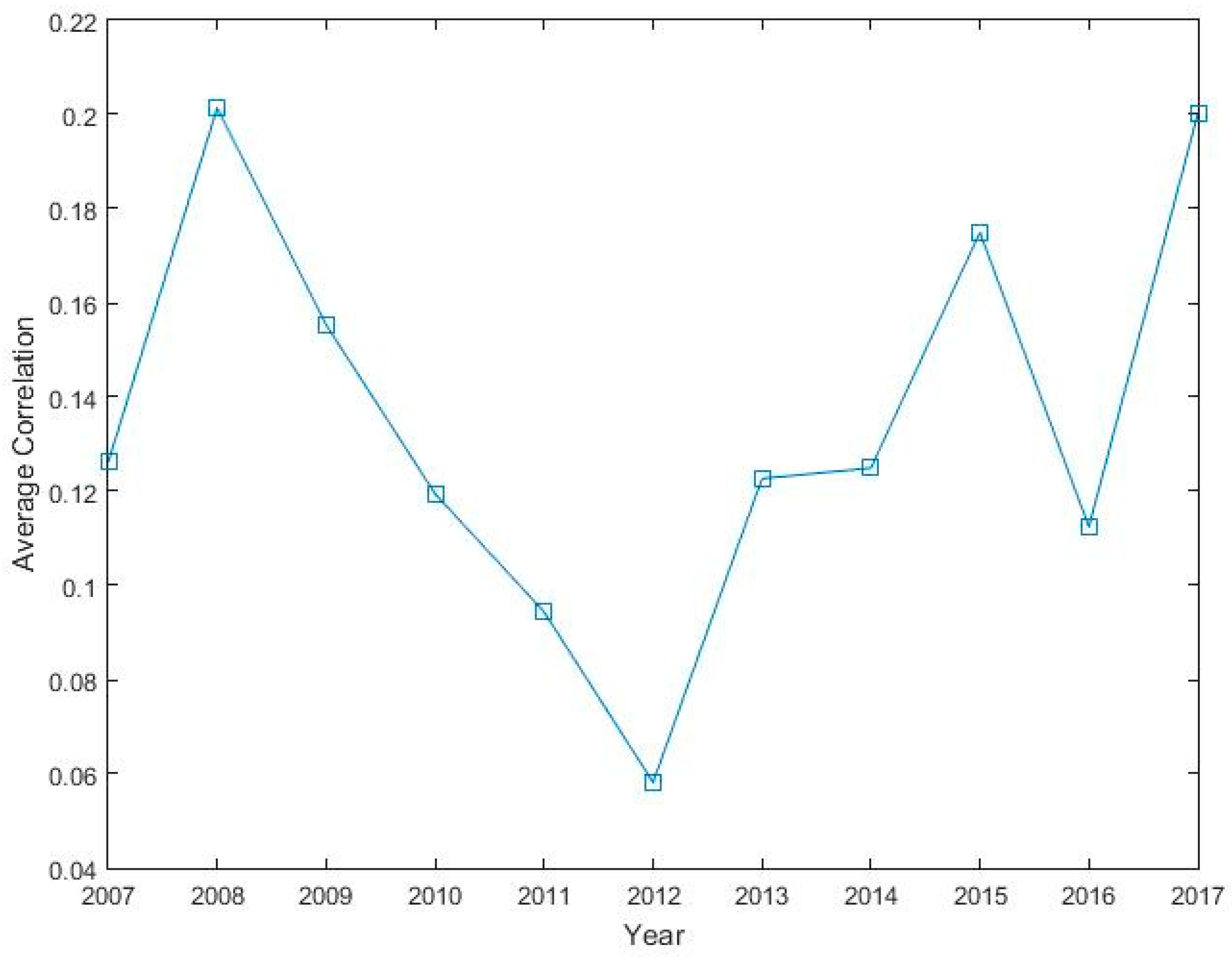
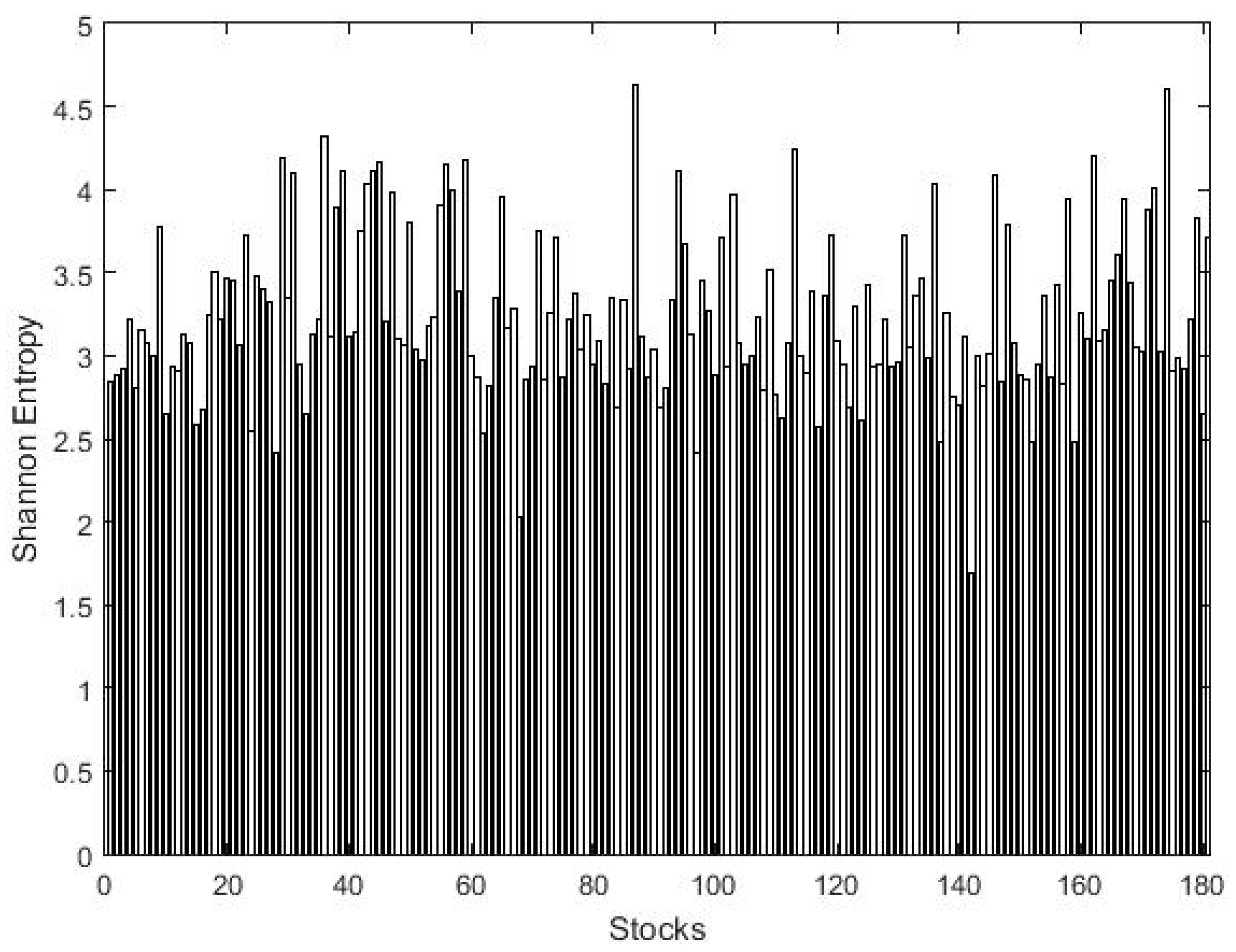
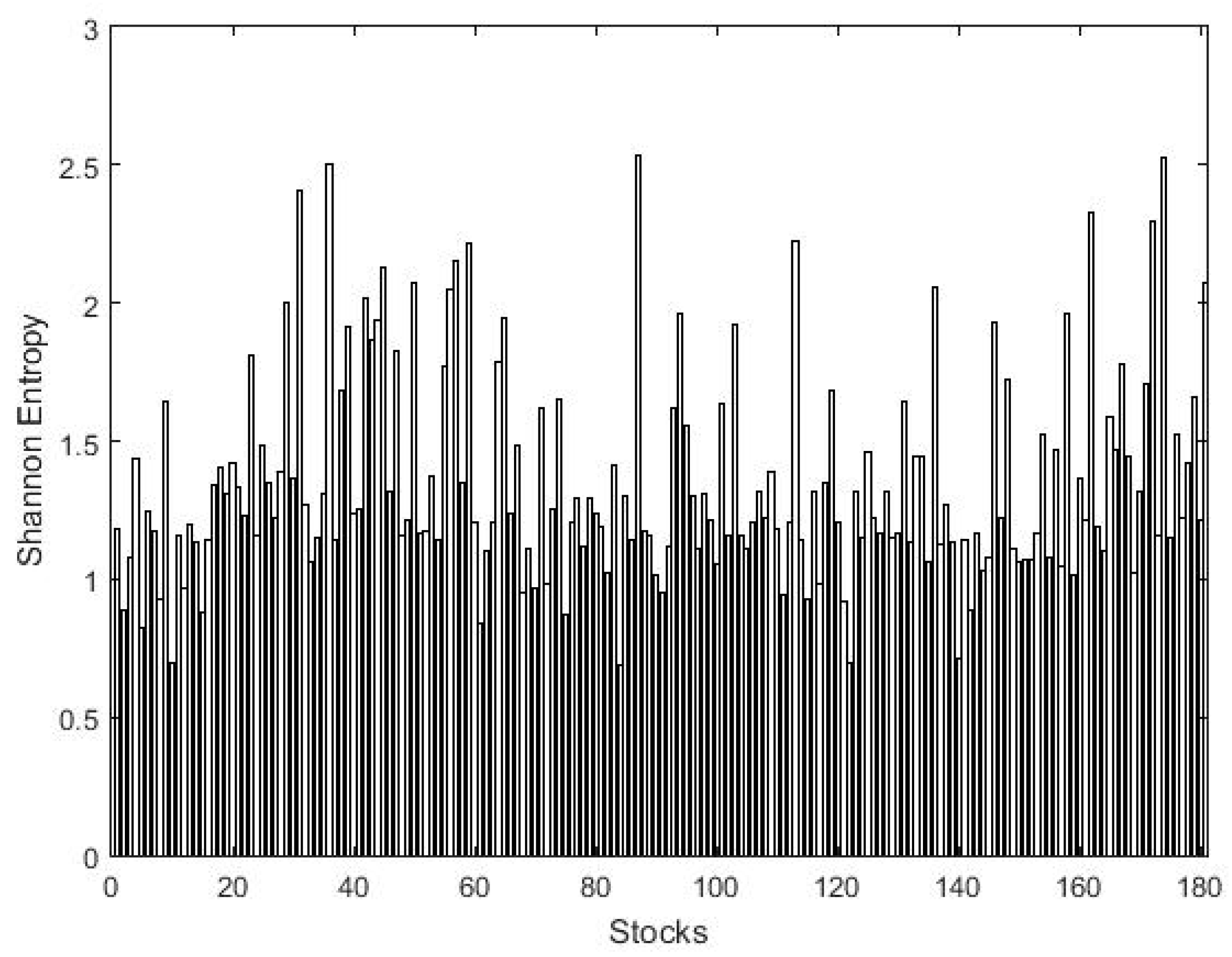
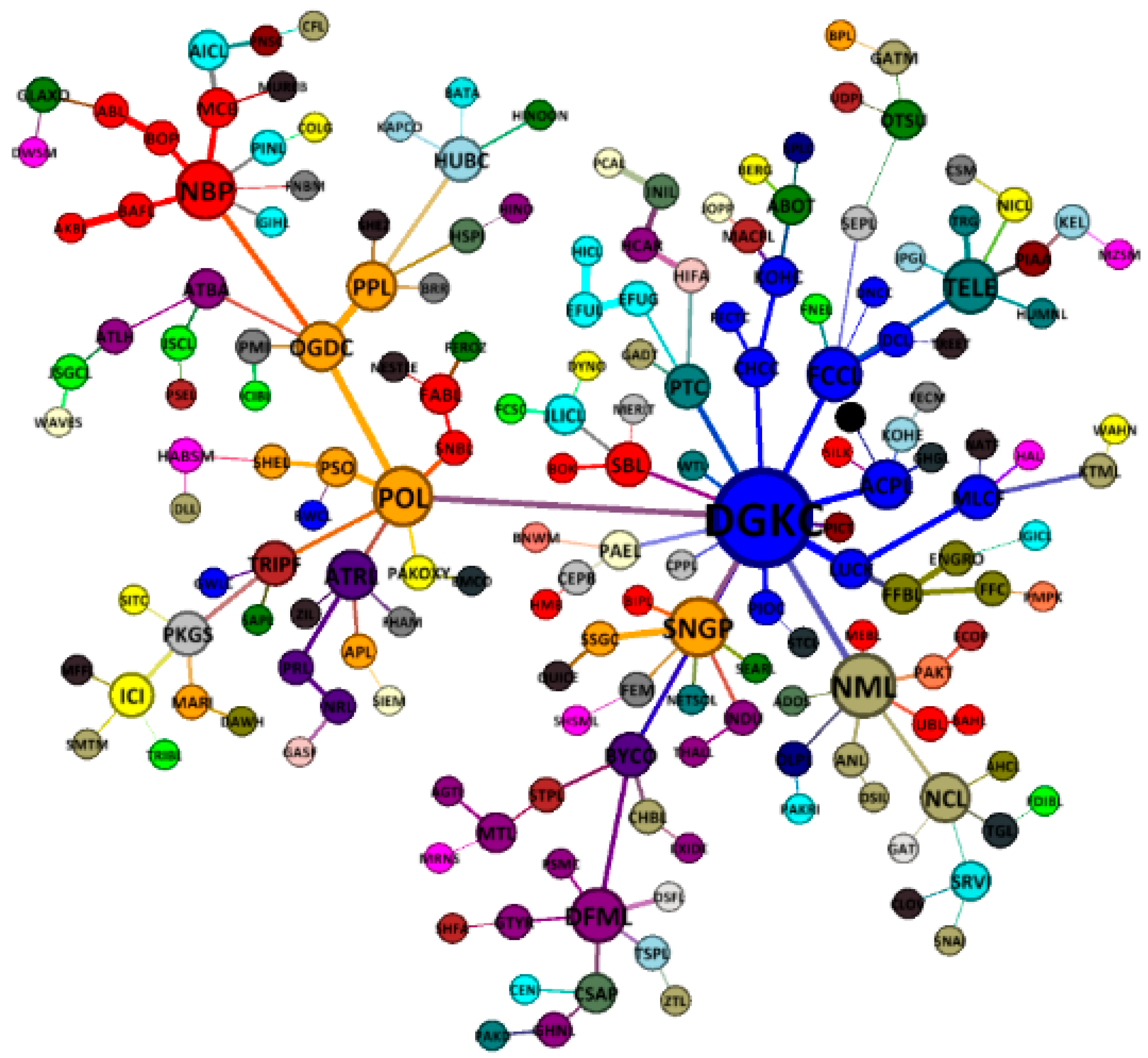
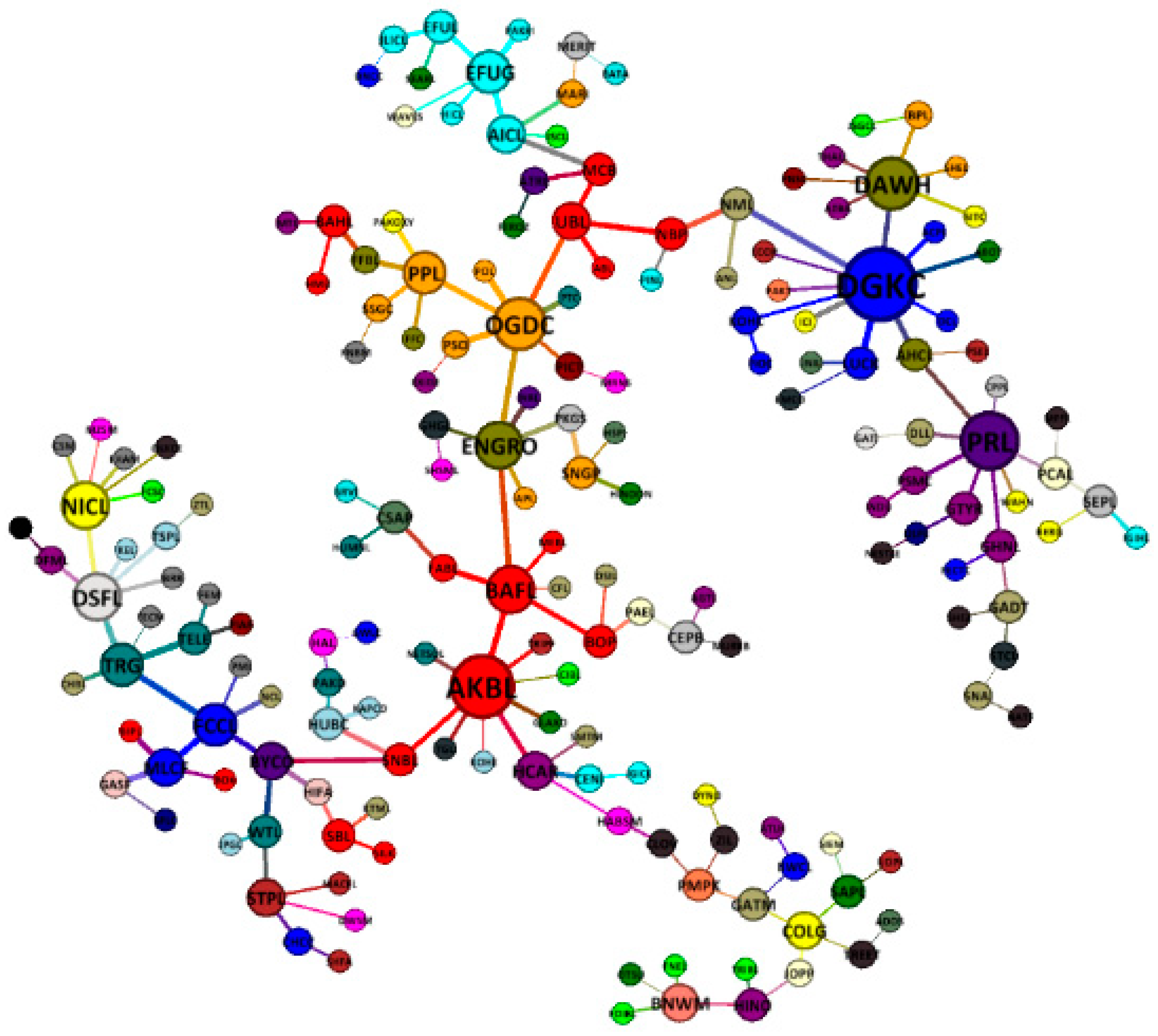
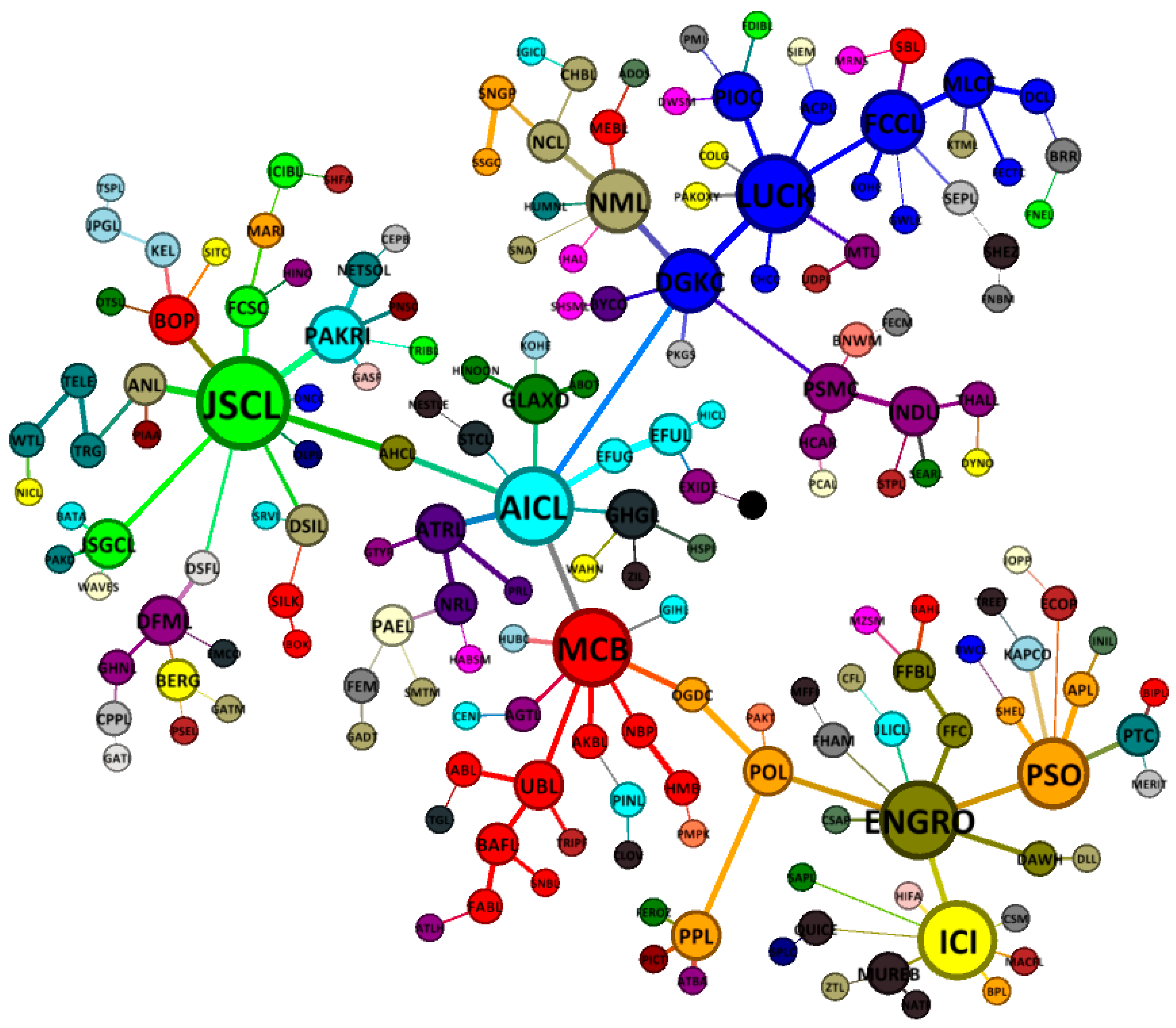
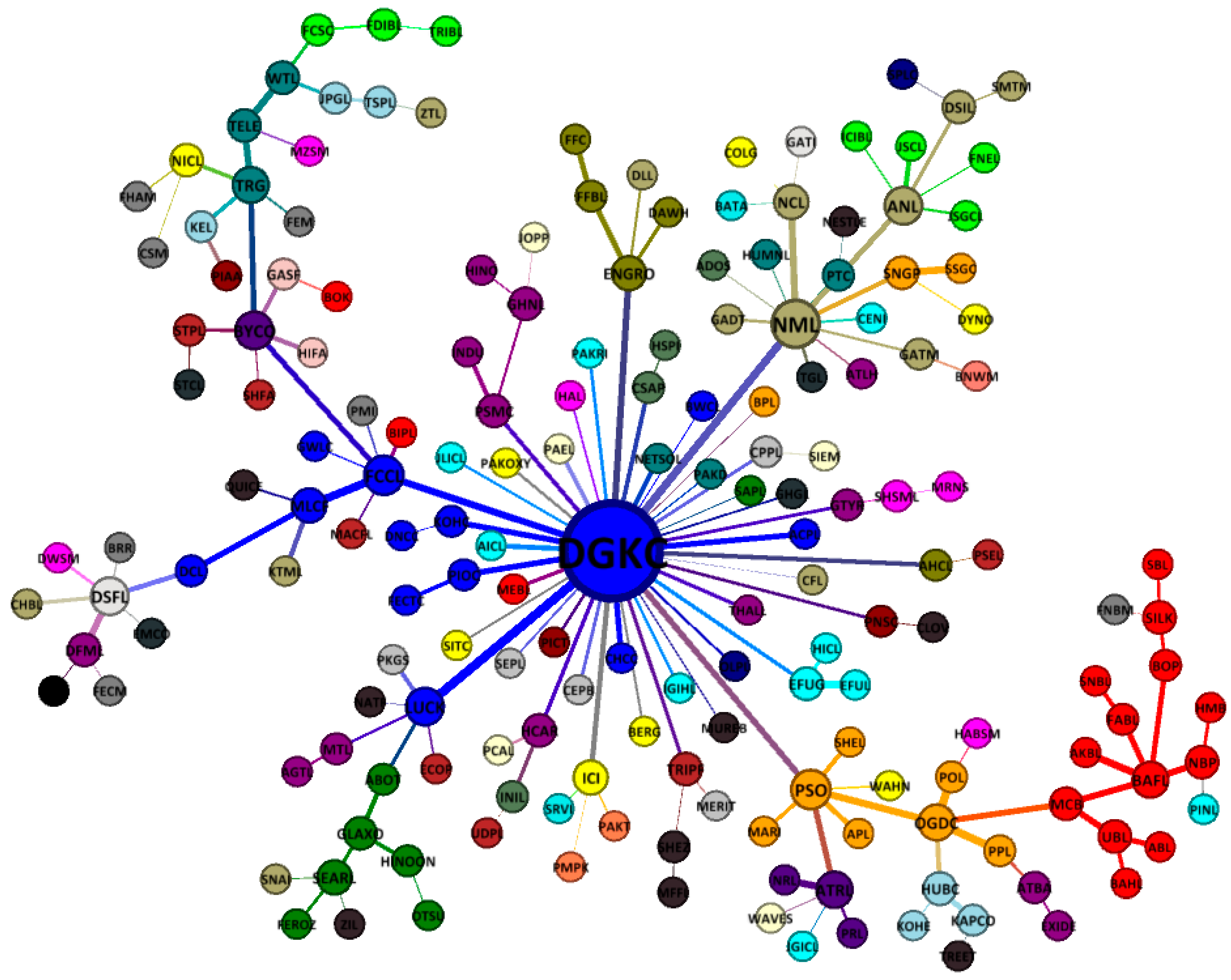
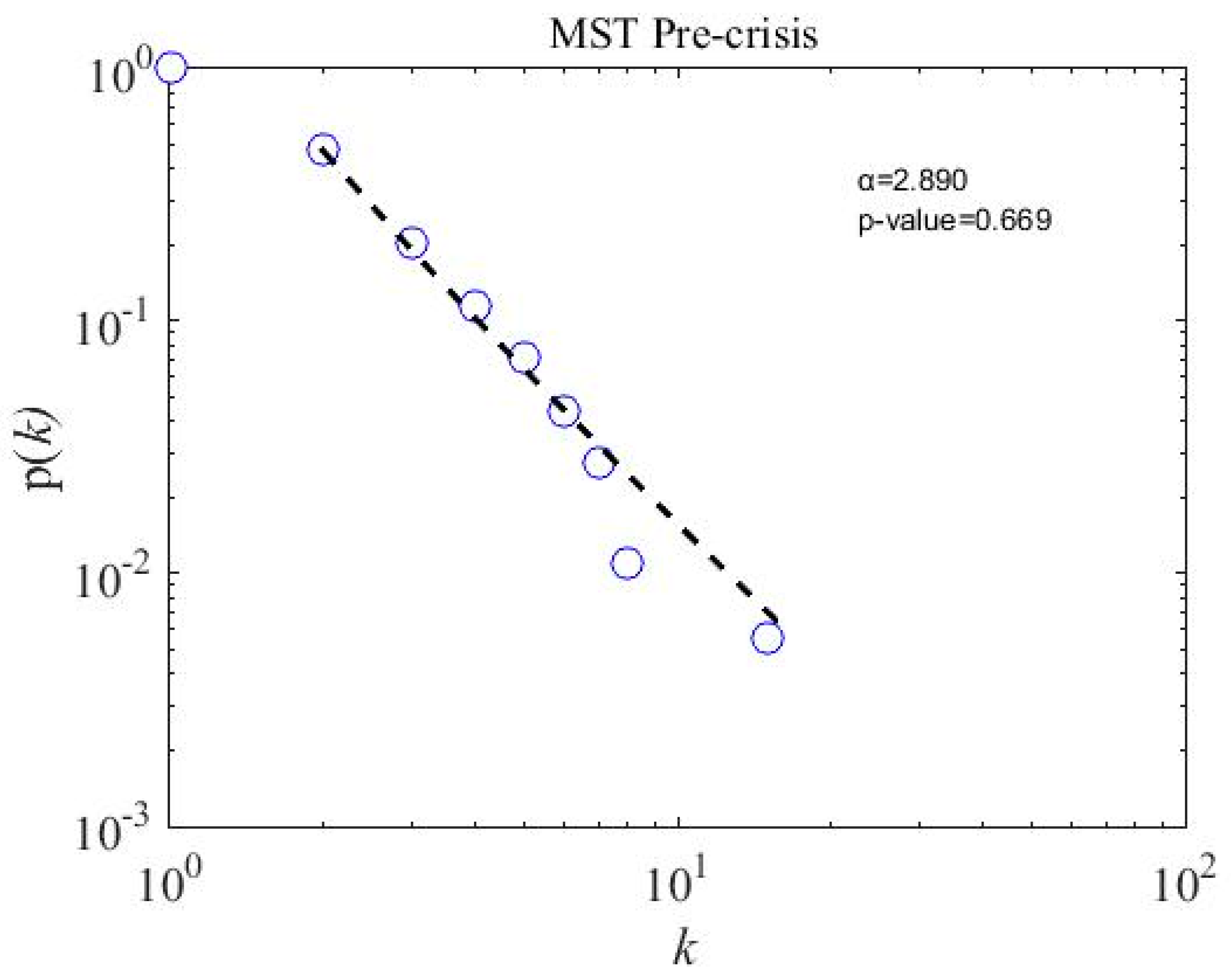
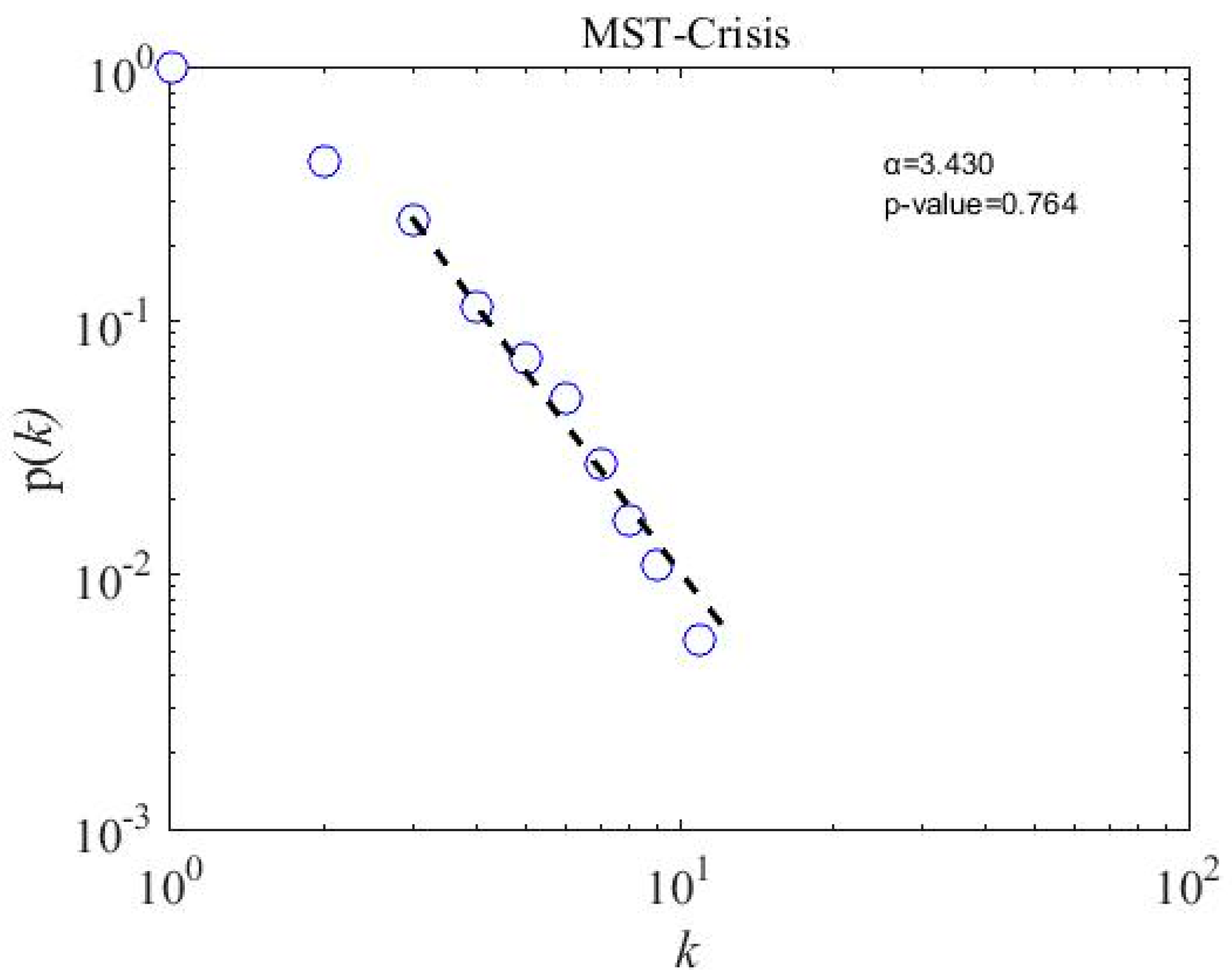
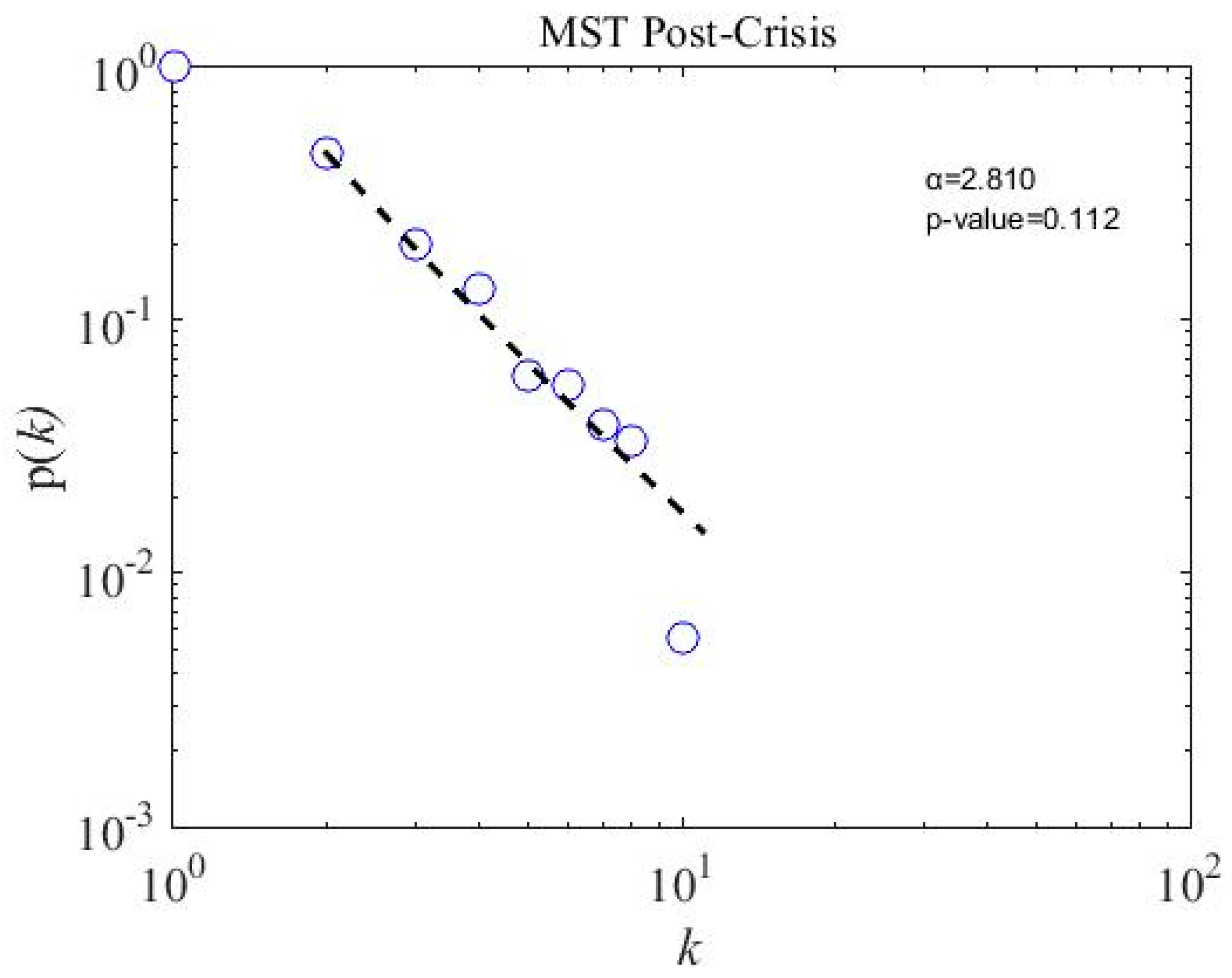
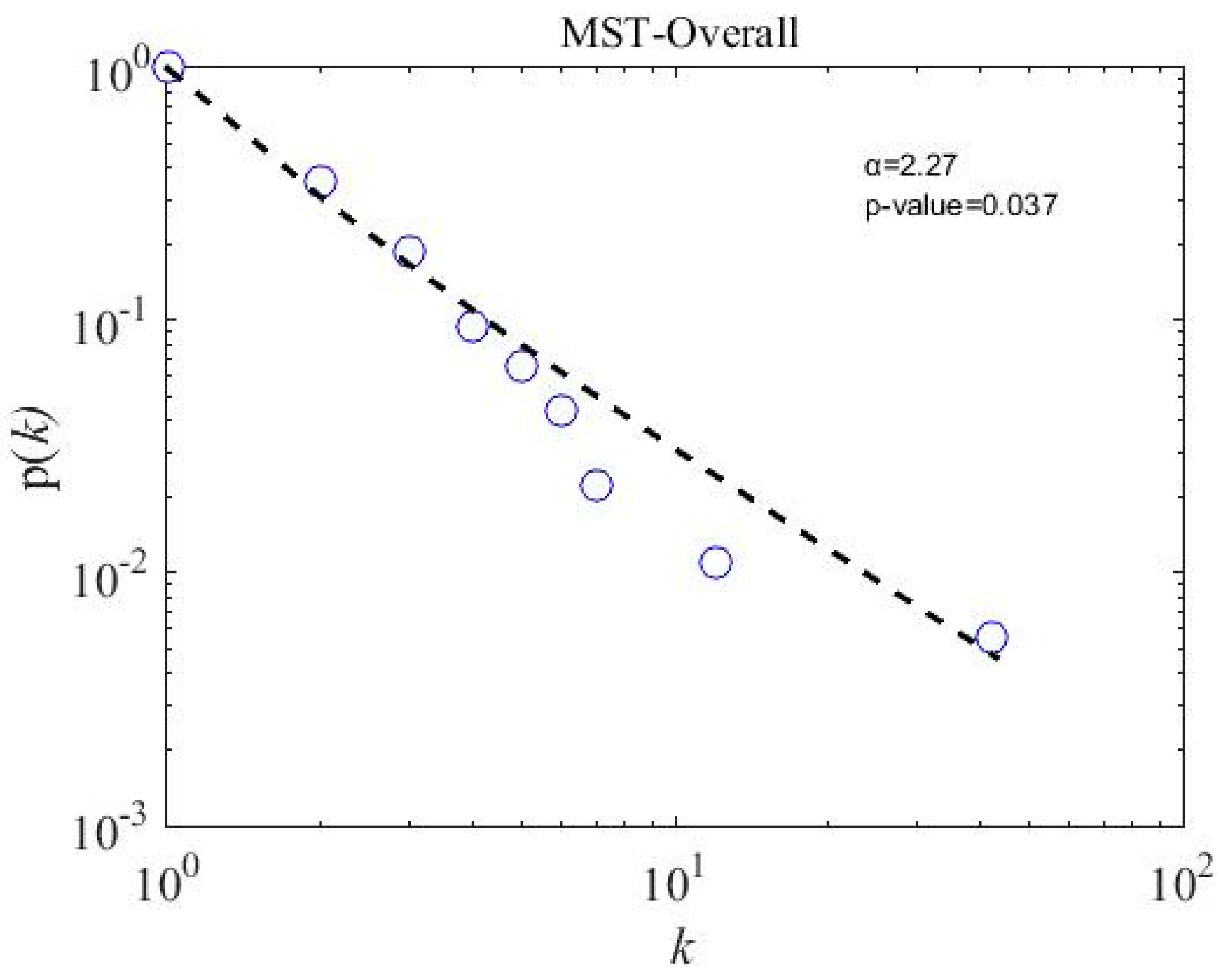
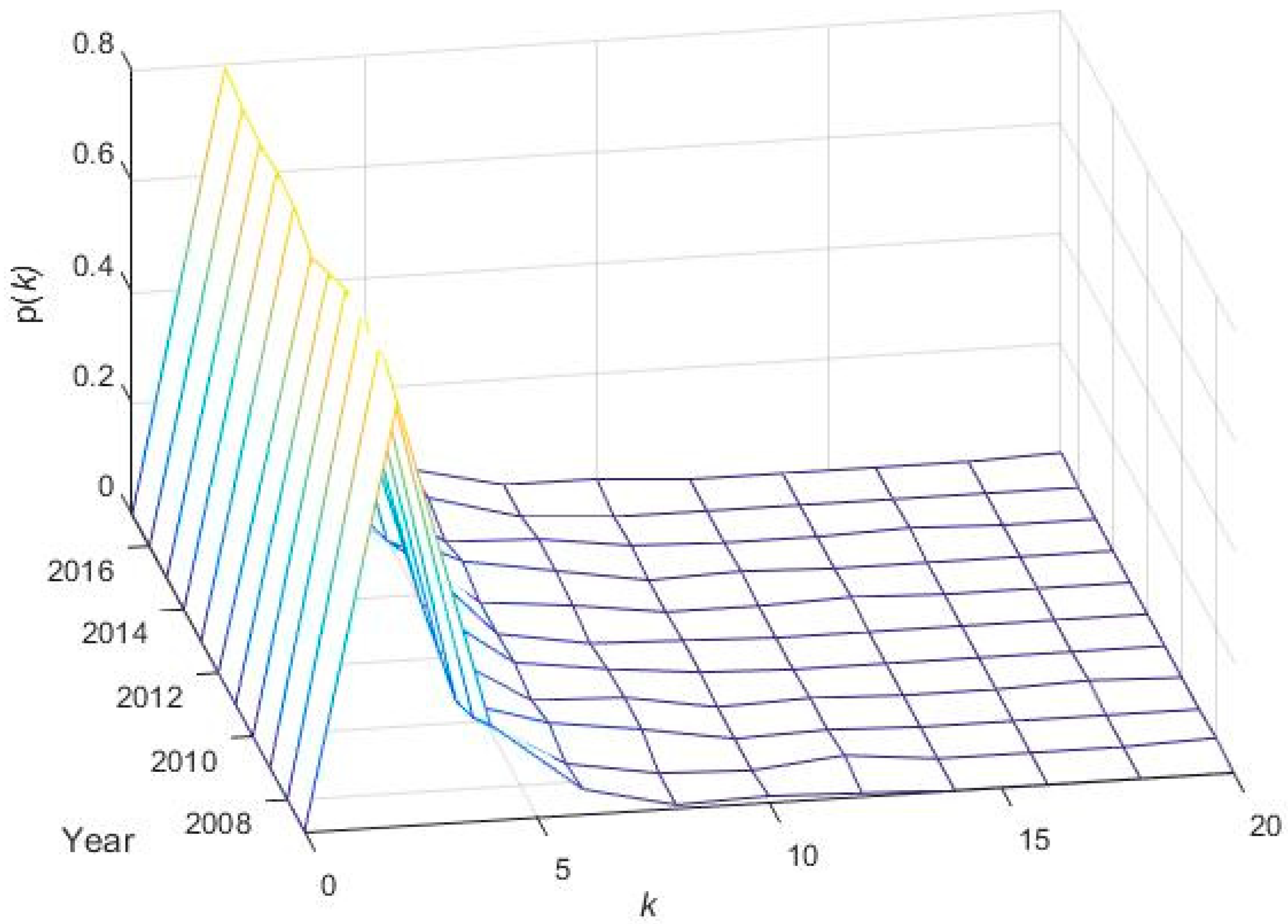
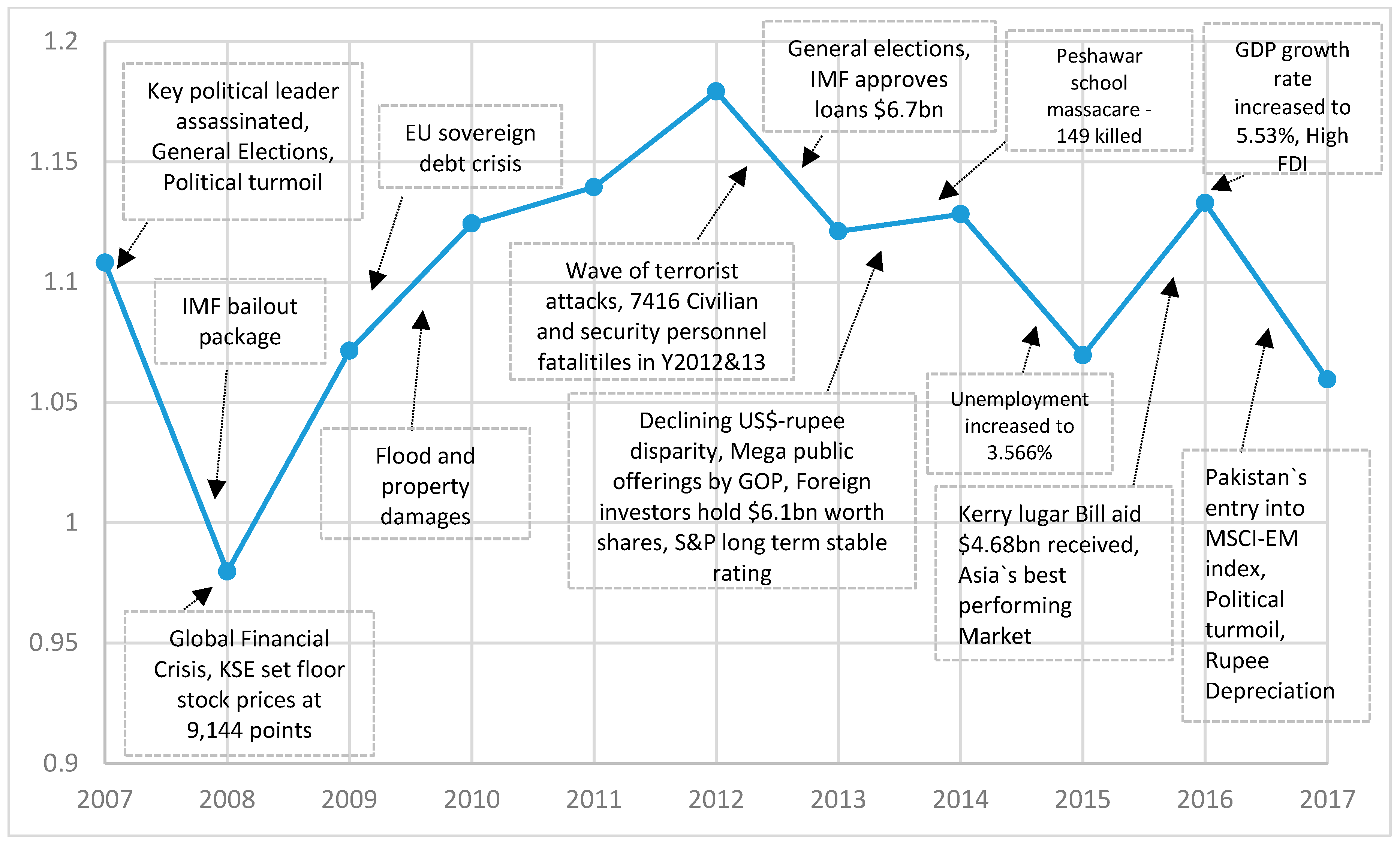
| S. No | Sector | Color | Number of Companies |
|---|---|---|---|
| 1 | Automobile Assembler | Purple | 9 |
| 2 | Automobile Parts and Accessories | Purple | 4 |
| 3 | Cable and Electric Goods | Cream | 5 |
| 4 | Cement | Blue | 13 |
| 5 | Chemical | Yellow | 8 |
| 6 | Close-End Mutual Fund | Rose gold | 2 |
| 7 | Commercial Banks | Red | 16 |
| 8 | Engineering | Hazel Green | 4 |
| 9 | Fertilizer | Olive | 5 |
| 10 | Food and Personal Care Products | Charcoal | 9 |
| 11 | Glass and Ceramics | Gunmetal | 4 |
| 12 | Insurance | Cyan | 10 |
| 13 | Inv. Banks/Inv. Cos./Securities Cos. | Lime | 7 |
| 14 | Jute | Black | 1 |
| 15 | Leasing | Navy | 2 |
| 16 | Leather and Tanneries | Celeste | 2 |
| 17 | Miscellaneous | Brown | 7 |
| 18 | Modarabas | Grey | 7 |
| 19 | Oil and Gas Exploration Companies | Orange | 4 |
| 20 | Oil and Gas Marketing Companies | Orange | 6 |
| 21 | Paper and Board | Silver | 5 |
| 22 | Pharmaceuticals | Green | 7 |
| 23 | Power Generation and Distribution | Light blue | 6 |
| 24 | Refinery | Indigo | 4 |
| 25 | Sugar and Allied Industries | Magenta | 6 |
| 26 | Synthetic and Rayon | Platinum | 2 |
| 27 | Technology and Communication | Teal | 7 |
| 28 | Textile Composite | Khaki | 7 |
| 29 | Textile Spinning | Khaki | 4 |
| 30 | Textile Weaving | Khaki | 2 |
| 31 | Tobacco | Coral | 2 |
| 32 | Transport | Maroon | 3 |
| 33 | Woollen | Salmon | 1 |
| Distance | Pearson Correlation Coefficient | |||||
|---|---|---|---|---|---|---|
| Mean | Maximum | Minimum | Mean | Maximum | Minimum | |
| Precrisis | 1.311 | 1.744 | 0.635 | 0.137 | 0.799 | −0.521 |
| Crisis | 1.265 | 1.585 | 0.641 | 0.191 | 0.795 | −0.255 |
| Postcrisis | 1.313 | 1.554 | 0.693 | 0.134 | 0.760 | −0.208 |
| Overall | 1.319 | 1.450 | 0.786 | 0.128 | 0.691 | −0.051 |
| Rank | Node | Sector | Entropy with bins 0.01 | Entropy with bins 0.05 |
|---|---|---|---|---|
| List of top five stocks with the highest Shannon entropy scores | ||||
| 1 | ICIBL | Inv. Banks/Inv. Cos./Securities Cos. | 4.634 | 2.533 |
| 2 | TSPL | Power Generation and Distribution | 4.607 | 2.525 |
| 3 | CSM | Modarabas | 4.318 | 2.503 |
| 4 | MZSM | Sugar and Allied Industries | 4.245 | 2.226 |
| 5 | SPLC | Leasing | 4.209 | 2.324 |
| List of top five stocks with the lowest Shannon entropy scores | ||||
| 1 | PSEL | Miscellaneous | 1.694 | 0.887 |
| 2 | GATI | Synthetic and Rayon | 2.025 | 0.948 |
| 3 | KAPCO | Power Generation and Distribution | 2.415 | 1.111 |
| 4 | CFL | Textile Spinning | 2.421 | 1.389 |
| 5 | SHEZ | Food and Personal Care Products | 2.484 | 1.073 |
| Precrisis | Crisis | Postcrisis | |||||||
|---|---|---|---|---|---|---|---|---|---|
| p >0.1 | p > 0.3 | p > 0.5 | p > 0.1 | p > 0.3 | p > 0.5 | p > 0.1 | p > 0.3 | p > 0.5 | |
| Nodes | 181 | 123 | 37 | 181 | 161 | 86 | 181 | 107 | 49 |
| Retaining Edges | 9684 | 1250 | 74 | 10975 | 3891 | 669 | 9370 | 1421 | 94 |
| % of Retaining Edges | 59 | 8 | 0.45 | 67.37 | 23.89 | 4.11 | 57.52 | 8.72 | 0.58 |
| Average Degree | 107.006 | 20.325 | 4 | 121.271 | 48.335 | 15.558 | 103.536 | 26.561 | 3.837 |
| Network Diameter | 3 | 5 | 7 | 3 | 9 | 6 | 3 | 5 | 7 |
| Average Path Length | 1.411 | 2.163 | 2.545 | 1.329 | 2.245 | 2.399 | 1.431 | 1.964 | 2.777 |
| Graph Density | 0.594 | 0.167 | 0.111 | 0.674 | 0.302 | 0.183 | 0.575 | 0.251 | 0.08 |
| Communities | 5 | 8 | 8 | 4 | 5 | 5 | 5 | 5 | 9 |
| Modularity | 0.044 | 0.134 | 0.459 | 0.09 | 0.167 | 0.273 | 0.041 | 0.109 | 0.417 |
© 2019 by the authors. Licensee MDPI, Basel, Switzerland. This article is an open access article distributed under the terms and conditions of the Creative Commons Attribution (CC BY) license (http://creativecommons.org/licenses/by/4.0/).
Share and Cite
Memon, B.A.; Yao, H. Structural Change and Dynamics of Pakistan Stock Market during Crisis: A Complex Network Perspective. Entropy 2019, 21, 248. https://doi.org/10.3390/e21030248
Memon BA, Yao H. Structural Change and Dynamics of Pakistan Stock Market during Crisis: A Complex Network Perspective. Entropy. 2019; 21(3):248. https://doi.org/10.3390/e21030248
Chicago/Turabian StyleMemon, Bilal Ahmed, and Hongxing Yao. 2019. "Structural Change and Dynamics of Pakistan Stock Market during Crisis: A Complex Network Perspective" Entropy 21, no. 3: 248. https://doi.org/10.3390/e21030248
APA StyleMemon, B. A., & Yao, H. (2019). Structural Change and Dynamics of Pakistan Stock Market during Crisis: A Complex Network Perspective. Entropy, 21(3), 248. https://doi.org/10.3390/e21030248





